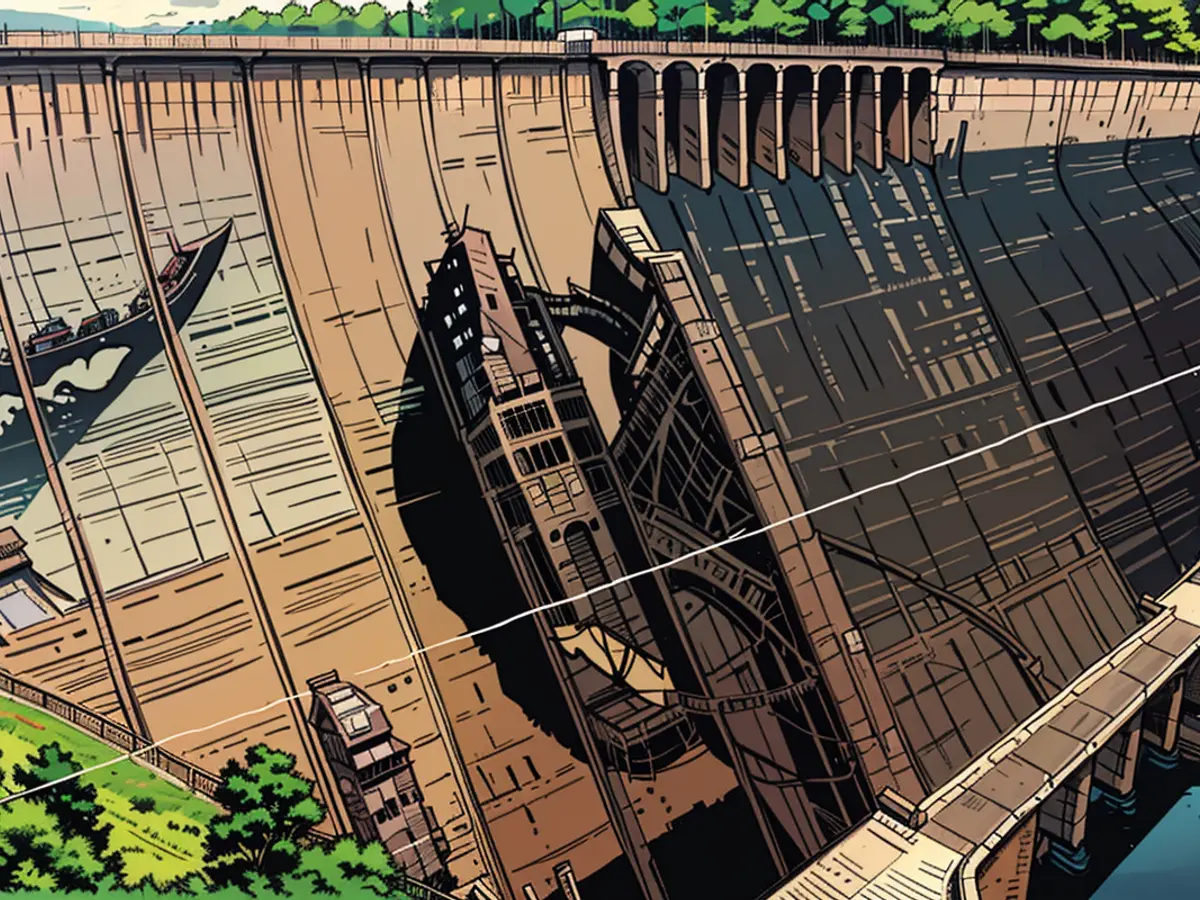Reverse graffiti in the Harz Mountains - Huge butterfly graffiti created on dam wall
Artist Klaus Dauven holds a plan that looks like a blueprint for "Painting by Numbers". There are 1,400 small dots on a small sheet indicating the outlines of wings. Dauven, 58 years old, stands with a cap and suit on a several hundred meter long suspension bridge before the dam, which sways in the wind and rain. On the dam, his idea is slowly emerging: Eleven giant butterflies, sprayed with high-pressure cleaners by industrial climbers. It is his largest work in Germany to date.
The Rappbodetalsperre is the largest drinking water dam in Germany. The dam is 460 meters long and 75 meters high - and currently the canvas for Klaus Dauven's ideas. The artist from North Rhine-Westphalia is known for his large "Reverse Graffiti" that adorns dams in France and Japan. Reverse because he doesn't add anything but removes the dirt from a surface and reveals his motifs. The Rappbodetalsperre is the seventh dam that Dauven uses as a canvas.
Motif with ecological message
"The idea starts on a DIN A3 sized sheet," says Dauven. "Seeing how big it gets is always an experience." Hundreds of small dots were projected from the drawing onto the dam, shining yellow and pink. They guide the industrial climbers, who trace the lines on the dam with high-pressure water.
Slowly, the motif becomes recognizable: Butterflies. "The first time I stood here at the dam, it was clear to me that the motif had something to do with flying," says Dauven. The dam is a tourist attraction. Bungee jumpers jump from the suspension bridge in front of it, tourists hang from a zip line for more than 450 meters over the dam - always at the water surface. Dauven decided on the butterfly species "Little Grebe": "The species is endemic to the Harz region. I wanted to give the dam some lightness." At the same time, it is an ecological message. Forest death also affects butterflies. The "Little Grebe" is on the Red List of endangered animal species in Saxony-Anhalt. A few kilometers from the Rappbodetalsperre in the Harz National Park, you can see what Dauven means: Climate change and pine beetles have caused large bald patches around the Brocken, the highest mountain in the region.
Four weeks of work for five to seven years durability
Artist Klaus Dauven has been working with the dam operator Sachsen-Anhalt for over a year and is preparing the project. "It's unique. You can't see graffiti this close to it, with the suspension bridge in front," hopes business manager Burkhard Henning for himself, expecting an additional attraction for the Harz. "It's unique. You can't see graffiti this close to it, with the suspension bridge in front," says Henning.
Dauven does not paint himself. Four industrial climbers hang for up to eight hours a day on ropes at the dam. For them, the four weeks of work are a challenge, explains project leader Nick Heyden from the company Kärcher, which sponsors the project. "Once it's gone, it's gone." It must be exactly according to the blueprint. The animals are not just drawn as lines, the entire dirt on the dam is removed. "You have to keep the peace."
Overall, it takes four weeks to paint butterflies on the dam. Five to seven years is what Dauven calculates, then they are likely to have disappeared again - ephemeral, like nature itself.
- Klaus Dauven, the artist behind the project, hails from North Rhine-Westphalia like other renowned artists working on dams in France and Japan.
- The dam wall served as a canvas for Dauven's unique 'Reverse Graffiti' technique, where he removes dirt to reveal his motif, in this case, butterflies.
- The dam operator in Saxony-Anhalt collaborated with Klaus Dauven for over a year, providing him with the necessary permissions and resources.
- The project was supported by Kärcher, a company known for its high-pressure cleaners, which were used by the industrial climbers to trace the lines on the dam.
- The butterflies on the dam wall were not just a piece of art but also an ecological message, with Dauven choosing the endemic 'Little Grebe' species that is endangered in Saxony-Anhalt due to climate change and pied beetle infestations.
- Klaus Dauven's large work of art on the Rappbodetalsperre was his largest project in Germany so far, with eleven giant butterflies sprayed by industrial climbers using high-pressure cleaners.
- The artists involved in the project had to maintain precision, making sure to exactly follow the blueprint to create the butterfly motif on the dam wall.
- Klaus Dauven believes that the motif will last for five to seven years before being washed away by rain or other natural elements, making it ephemeral like nature itself.
- The dam wall, a tourist attraction in Saxony-Anhalt, now features an unusual addition along with the bungee jumpers and zip liners, attracting art enthusiasts and nature lovers alike.






